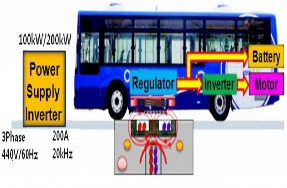Energy Efficient Vehicles
♤ Scientists from South Korea have introduced the world’s first road-powered electric vehicle network.
♤ This new technology is called Shaped Magnetic Field in Resonance (SMFIR) and it consists of special roads that have electrical cables buried just below the surface, which wirelessly transfer energy to electric vehicles (known as online electric vehicles, OLEV) via magnetic resonance while moving.

♤ The length of power strips installed under the road is generally 5%-15% of the entire road, requiring only few sections of the road to be rebuilt with the embedded cables.
♤ Road-powered electric vehicles only require small batteries, significantly reducing their overall weight and thus their energy consumption.
♤ Also, with an electrified roadway, the need of plugging vehicles in to recharge it is done away, removing most of the risk and range anxiety associated with electric vehicles (EVs).
♤ The power supply is only switched on when LEV buses pass along, but is switched off for other vehicles, thereby preventing electromagnetic fields exposure and standby power consumption.
♤ We can expect more research to reduce the complexities of technology and result in cheaper, lighter and more efficient vehicles.


